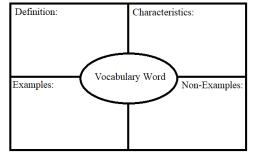General Information
Benchmark Instructional Guide
Connecting Benchmarks/Horizontal Alignment
Terms from the K-12 Glossary
- Quadratic Function
- -intercept
- -intercept
Vertical Alignment
Previous Benchmarks
Next Benchmarks
Purpose and Instructional Strategies
In grade 8, students multiplied two linear expressions to obtain a quadratic expression. In Algebra I, students transform a quadratic function to highlight and interpret its vertex or its zeroes. In later courses, students will determine key features of higher degree polynomials.- Instruction includes making connections to various forms of quadratic equations to show
their equivalency. Students should understand and interpret when one form might be
more useful than other depending on the context.
- Standard Form
Can be described by the equation = 2+ + , where , and are any rational number. This form can be useful when identifying the -intercept. - Factored form
Can be described by the equation = ( − 1)( − 2), where 1 and 2 are real numbers and the roots, or -intercepts. This form can be useful when identifying the -intercepts, or roots. - Vertex form
Can be described by the equation = ( − )2 + , where the point (, ) is the vertex. This form can be useful when identifying the vertex.
- Standard Form
- Instruction includes the use of - notation and function notation.
- Most contexts for this benchmark will present functions in standard form. Depending on
their perspectives, students might take several approaches to determine vertices and
zeros. Have students discuss strategies they might use. Let students know they should use
the approach that is most efficient for them (MTR.3.1).
- To determine zeros, students could use the quadratic formula or convert the function into factored form, or complete the square, or use Loh’s method.
- To determine the vertex, students could convert the function into vertex form or determine the axis of symmetry ( = ). Calculate this value from one of the previous functions discussed and guide students to see that the vertex of each parabola falls on the
line of symmetry. Considering this, they can substitute that
y y
Common Misconceptions or Errors
- Some students may have difficulty interpreting the meaning of the zeros and vertex.
Strategies to Support Tiered Instruction
- Teacher provides a graphic organizer for key terms (zeros and vertex) that can be created using information provided in a given problem.

- Teacher co-creates a graphic organizer to compare real-world and mathematical contexts
related to quadratics.
- For example, the chart below can be used to compare mathematical terms with
real-world context.

- For example, the chart below can be used to compare mathematical terms with
real-world context.
- Teacher provides a visual aid, including using graphing software, to interpret the zeros
and vertex of a quadratic function. Students can compare definitions and examples to
determine the zeros and vertex of the parabola.
- For example, the roots of the graph shown are (2, 0) and (−4, 0). The locations
on the graph that intersect the
x
- For example, the roots of the graph shown are (2, 0) and (−4, 0). The locations
on the graph that intersect the

Instructional Tasks
Instructional Task 1 (MTR.3.1, MTR.6.1, MTR.7.1)- A diver jumps off a cliff 5 meters high into a lake. The diver’s position can be represented by
the function
h t t t h t - Part A. Determine the roots of the function described.
- Part B. Interpret each with respect to the situation.
Instructional Task 2 (MTR.3.1, MTR.7.1)
- A local campground charges $23.50 per night per campsite. They average about 32 campsites
rented each night. A recent survey indicated that for every $0.50 decrease, the number of
campsites rented increases by five.
- Part A. Write a quadratic equation that describes this situation.
- Part B. Determine the vertex and zeroes of the function described.
- Part C. Interpret each with respect to the situation.
- Part D. What price will maximize revenue?
Instructional Items
Instructional Item 1- Marcus just purchased a Super Bouncy Ball from a local toy store. Once outside, he throws it
down to see how high the ball will bounce. The function
h x x x h x
